Abstract
OBJECTIVE--To study the immediate and long-term clinical success of percutaneous transluminal coronary angioplasty in patients aged 35 years or less. DESIGN--Patients undergoing percutaneous transluminal angioplasty were prospectively entered into a dedicated database. Clinical and angiographic data on all patients aged 35 years or less were reviewed. Follow up data were collected by interview during outpatient visits, by questionnaire, or from referring physicians. SETTING--A tertiary referral cardiac centre. PATIENTS--57 patients aged 35 years or less (median 33, range 22-35) underwent coronary angioplasty because of unstable angina (32 patients), stable angina (23 patients), acute myocardial infarction (1 patient), and documented ischaemia in a cardiac transplant patient. RESULTS--The primary clinical success rate (reduction in diameter stenosis to < 50% without in-hospital events) was 88%. A major procedure related complication occurred in 5 patients (9%): one patient died, two patients sustained an acute myocardial infarction, two patients underwent emergency bypass surgery, and in three patients repeat angioplasty was performed before hospital discharge. In 2 patients (4%) coronary angioplasty did not significantly reduce the diameter stenosis but there were no associated complications. A total of 60 lesions were attempted (balloon angioplasty in 57, directional atherectomy in 2). The initial angiographic success rate was 92%. The median (SD) follow up was 4.7 (3.0) years. During follow up 7 patients (12%) died, 10 sustained a myocardial infarction (18%), and 28 patients (49%) underwent repeat revascularisation (coronary artery bypass grafting in 7 (12%) and repeat angioplasty in 21 (37%)). The estimated 5 year survival and event-free survival (Kaplan-Meier method) was 87 (9)% and 50 (13)%, respectively. Multivariate logistic regression analysis showed that hypertension and the extent of vessel disease were the only independent predictive factors for event free survival. CONCLUSIONS--In young patients coronary angioplasty had a high immediate success rate but many needed repeat revascularisation procedures during the follow up period and survival was not improved. Coronary angioplasty in young patients should be regarded as a palliative procedure.
Full text
PDF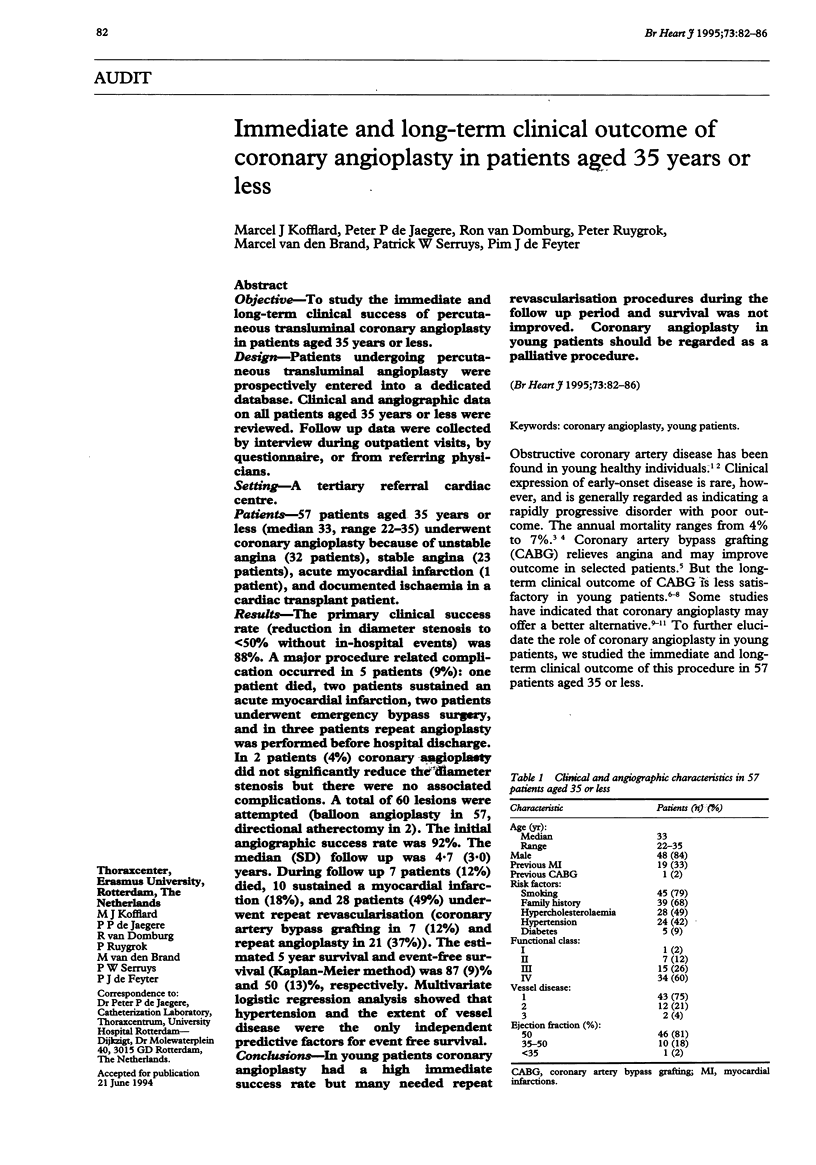
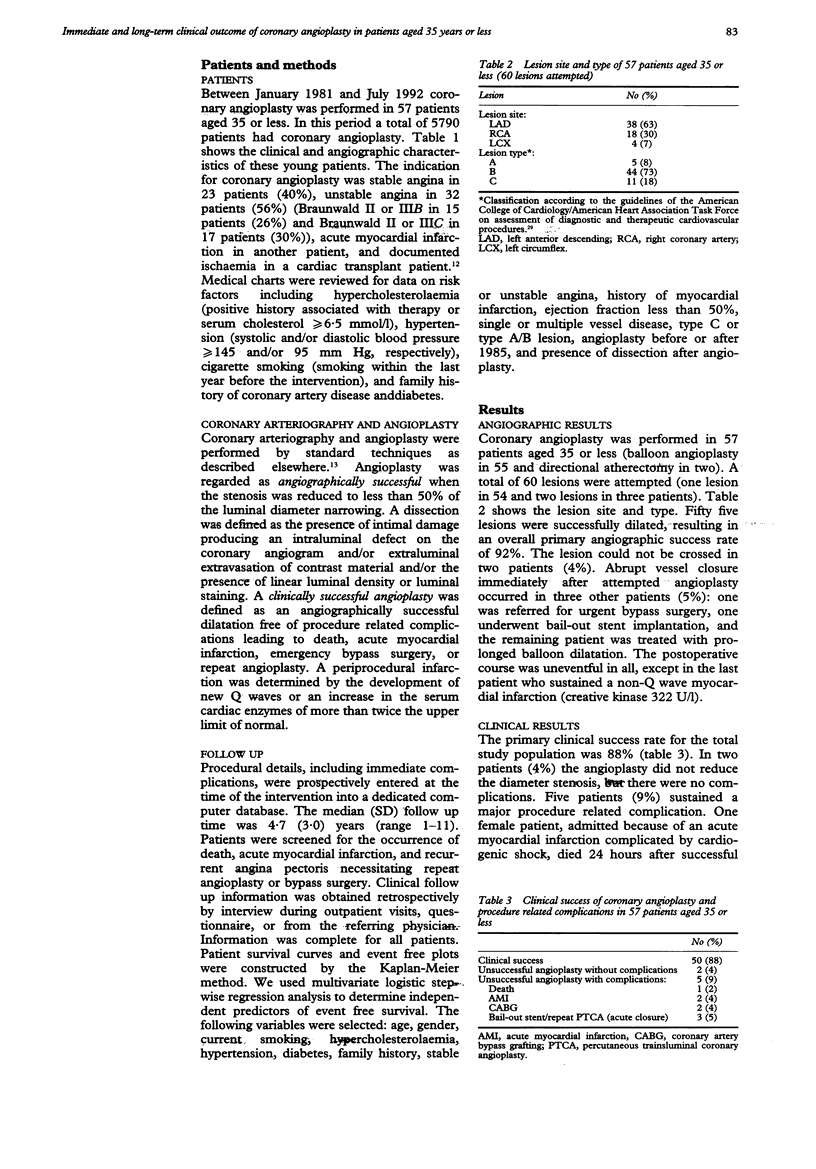
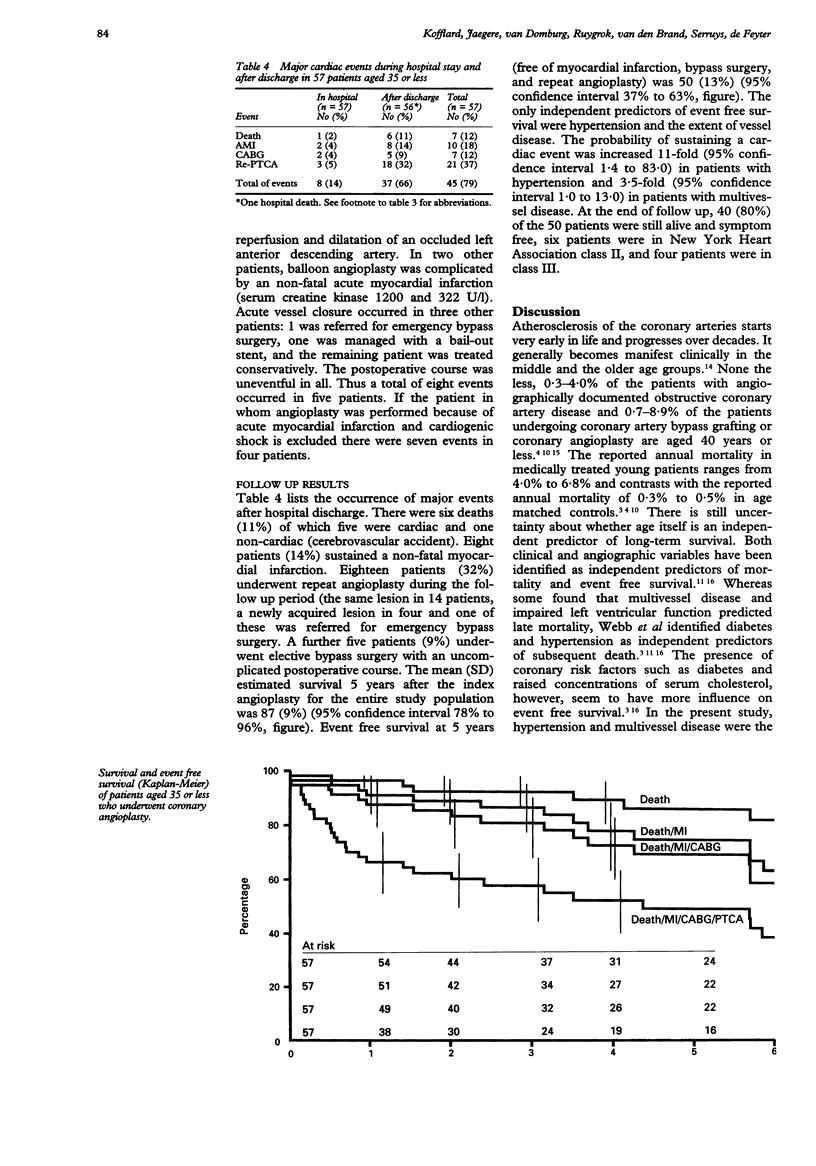
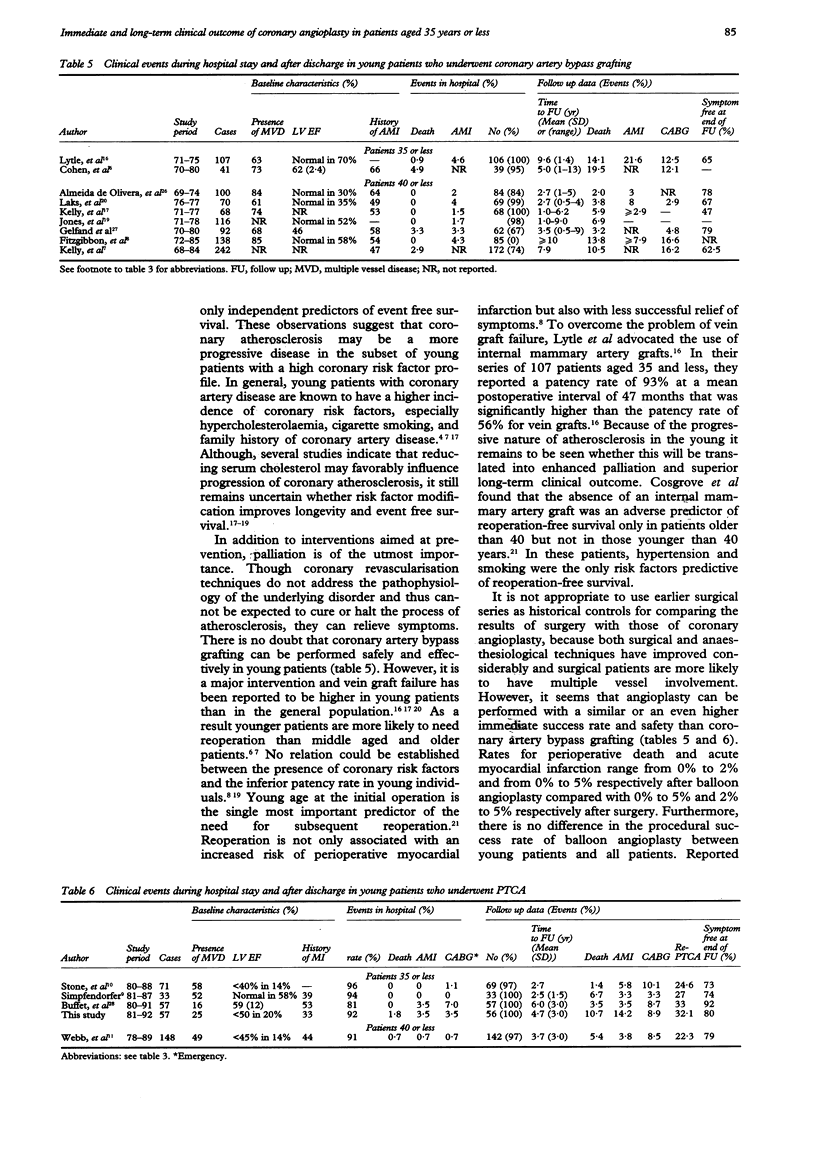
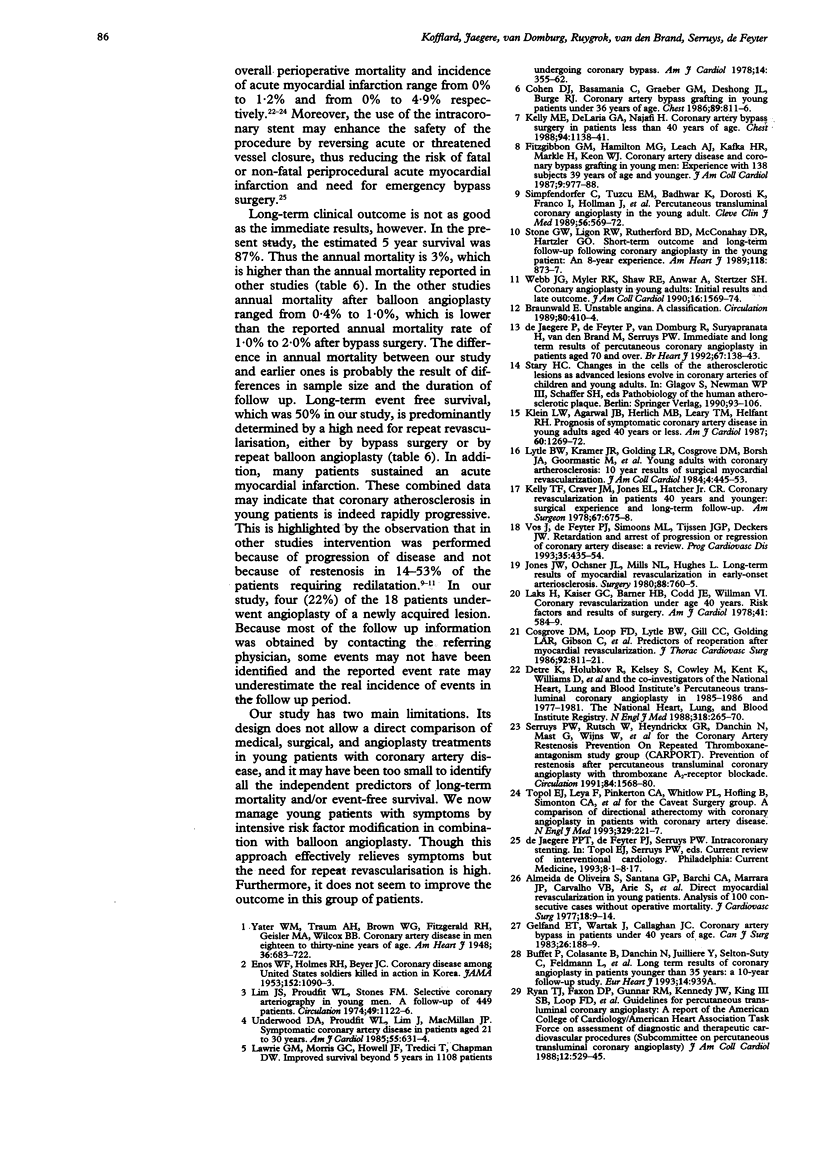
Selected References
These references are in PubMed. This may not be the complete list of references from this article.
- Almeida de Oliveira S., Santana G. P., Barchi C. A., Marrara J. P., Carvalho V. B., Arie S., Pileggi F., Macruz R., Zerbini E. J. Direct myocardial revascularization in young patients: analysis of 100 consecutive cases without operative mortality. J Cardiovasc Surg (Torino) 1977 Jan-Feb;18(1):9–14. [PubMed] [Google Scholar]
- Braunwald E. Unstable angina. A classification. Circulation. 1989 Aug;80(2):410–414. doi: 10.1161/01.cir.80.2.410. [DOI] [PubMed] [Google Scholar]
- Cohen D. J., Basamania C., Graeber G. M., Deshong J. L., Burge J. R. Coronary artery bypass grafting in young patients under 36 years of age. Chest. 1986 Jun;89(6):811–816. doi: 10.1378/chest.89.6.811. [DOI] [PubMed] [Google Scholar]
- Cosgrove D. M., Loop F. D., Lytle B. W., Gill C. C., Golding L. A., Gibson C., Stewart R. W., Taylor P. C., Goormastic M. Predictors of reoperation after myocardial revascularization. J Thorac Cardiovasc Surg. 1986 Nov;92(5):811–821. [PubMed] [Google Scholar]
- Detre K., Holubkov R., Kelsey S., Cowley M., Kent K., Williams D., Myler R., Faxon D., Holmes D., Jr, Bourassa M. Percutaneous transluminal coronary angioplasty in 1985-1986 and 1977-1981. The National Heart, Lung, and Blood Institute Registry. N Engl J Med. 1988 Feb 4;318(5):265–270. doi: 10.1056/NEJM198802043180501. [DOI] [PubMed] [Google Scholar]
- FitzGibbon G. M., Hamilton M. G., Leach A. J., Kafka H. P., Markle H. V., Keon W. J. Coronary artery disease and coronary bypass grafting in young men: experience with 138 subjects 39 years of age and younger. J Am Coll Cardiol. 1987 May;9(5):977–988. doi: 10.1016/s0735-1097(87)80297-8. [DOI] [PubMed] [Google Scholar]
- Gelfand E. T., Wartak J., Callaghan J. C. Coronary artery bypass in patients under 40 years of age. Can J Surg. 1983 Mar;26(2):188–189. [PubMed] [Google Scholar]
- Jones J. W., Ochsner J. L., Mills N. L., Hughes L. Long-term results of myocardial revascularization in early-onset arteriosclerosis. Surgery. 1980 Dec;88(6):760–765. [PubMed] [Google Scholar]
- Kelly M. E., DeLaria G. A., Najafi H. Coronary artery bypass surgery in patients less than 40 years of age. Chest. 1988 Dec;94(6):1138–1141. doi: 10.1378/chest.94.6.1138. [DOI] [PubMed] [Google Scholar]
- Kelly T. F., Craver J. M., Jones E. L., Hatcher C. R., Jr Coronary revascularization in patients 40 years and younger: surgical experience and long-term follow-up. Am Surg. 1978 Oct;44(10):675–678. [PubMed] [Google Scholar]
- Klein L. W., Agarwal J. B., Herlich M. B., Leary T. M., Helfant R. H. Prognosis of symptomatic coronary artery disease in young adults aged 40 years or less. Am J Cardiol. 1987 Dec 1;60(16):1269–1272. doi: 10.1016/0002-9149(87)90606-0. [DOI] [PubMed] [Google Scholar]
- Laks H., Kaiser G. C., Barner H. B., Codd J. E., Willman V. I. Coronary revascularization under age 40 years. Risk factors and results of surgery. Am J Cardiol. 1978 Mar;41(3):584–589. doi: 10.1016/0002-9149(78)90019-x. [DOI] [PubMed] [Google Scholar]
- Lim J. S., Proudfit W. L., Sones F. M., Jr Selective coronary arteriography in young men. A follow-up of 449 patients. Circulation. 1974 Jun;49(6):1122–1126. doi: 10.1161/01.cir.49.6.1122. [DOI] [PubMed] [Google Scholar]
- Lytle B. W., Kramer J. R., Golding L. R., Cosgrove D. M., Borsh J. A., Goormastic M., Loop F. D. Young adults with coronary atherosclerosis: 10 year results of surgical myocardial revascularization. J Am Coll Cardiol. 1984 Sep;4(3):445–453. doi: 10.1016/s0735-1097(84)80086-8. [DOI] [PubMed] [Google Scholar]
- Serruys P. W., Rutsch W., Heyndrickx G. R., Danchin N., Mast E. G., Wijns W., Rensing B. J., Vos J., Stibbe J. Prevention of restenosis after percutaneous transluminal coronary angioplasty with thromboxane A2-receptor blockade. A randomized, double-blind, placebo-controlled trial. Coronary Artery Restenosis Prevention on Repeated Thromboxane-Antagonism Study (CARPORT). Circulation. 1991 Oct;84(4):1568–1580. doi: 10.1161/01.cir.84.4.1568. [DOI] [PubMed] [Google Scholar]
- Simpfendorfer C., Tuzcu E. M., Badhwar K., Dorosti K., Franco I., Hollman J., Whitlow P. Percutaneous transluminal coronary angioplasty in the young adult. Cleve Clin J Med. 1989 Sep;56(6):569–572. doi: 10.3949/ccjm.56.6.569. [DOI] [PubMed] [Google Scholar]
- Stone G. W., Ligon R. W., Rutherford B. D., McConahay D. R., Hartzler G. O. Short-term outcome and long-term follow-up following coronary angioplasty in the young patient: an 8-year experience. Am Heart J. 1989 Nov;118(5 Pt 1):873–877. doi: 10.1016/0002-8703(89)90216-0. [DOI] [PubMed] [Google Scholar]
- Topol E. J., Leya F., Pinkerton C. A., Whitlow P. L., Hofling B., Simonton C. A., Masden R. R., Serruys P. W., Leon M. B., Williams D. O. A comparison of directional atherectomy with coronary angioplasty in patients with coronary artery disease. The CAVEAT Study Group. N Engl J Med. 1993 Jul 22;329(4):221–227. doi: 10.1056/NEJM199307223290401. [DOI] [PubMed] [Google Scholar]
- Underwood D. A., Proudfit W. L., Lim J., MacMillan J. P. Symptomatic coronary artery disease in patients aged 21 to 30 years. Am J Cardiol. 1985 Mar 1;55(6):631–634. doi: 10.1016/0002-9149(85)90126-2. [DOI] [PubMed] [Google Scholar]
- Vos J., de Feyter P. J., Simoons M. L., Tijssen J. G., Deckers J. W. Retardation and arrest of progression or regression of coronary artery disease: a review. Prog Cardiovasc Dis. 1993 May-Jun;35(6):435–454. doi: 10.1016/0033-0620(93)90028-c. [DOI] [PubMed] [Google Scholar]
- Webb J. G., Myler R. K., Shaw R. E., Anwar A., Stertzer S. H. Coronary angioplasty in young adults: initial results and late outcome. J Am Coll Cardiol. 1990 Dec;16(7):1569–1574. doi: 10.1016/0735-1097(90)90302-6. [DOI] [PubMed] [Google Scholar]
- de Jaegere P., de Feyter P., van Domburg R., Suryapranata H., van den Brand M., Serruys P. W. Immediate and long term results of percutaneous coronary angioplasty in patients aged 70 and over. Br Heart J. 1992 Feb;67(2):138–143. doi: 10.1136/hrt.67.2.138. [DOI] [PMC free article] [PubMed] [Google Scholar]


